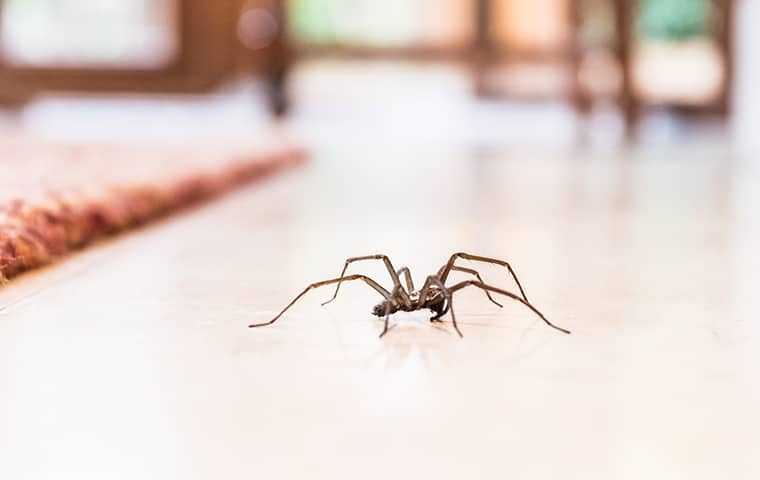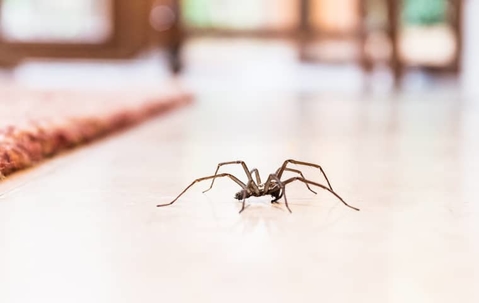
October 15, 2022
A spider here and there is not out of place in any home, but if you are beginning to see an increase in the number of spiders in your Bryan home, it is important to take notice. Many common house spiders are not necessarily hazardous to have in your home, but there are dangerous spiders in Texas. If you are not certain what kind of spiders you're seeing around your home, a Bryan pest control professional can help you identify the pests as well as remove them from your home.
The Ten Most Common House Spiders
There are any number of common household spiders in Texas. However, the ten you are most likely to find in your Bryan home include:
- Grass Spiders: These spiders have distinctive yellow and black markings on their abdomens. They spin sheet-like webs on grass and weeds and most often live outdoors but will sometimes enter homes when the weather cools.
- Orb Weavers: There are lots of different variations of orb weaver spiders, including black and yellow garden spiders. They spin giant webs. Like grass spiders, they are outdoor pests but often are found along the eaves of homes or in outbuildings and gardens.
- Woodlouse Hunter: These spiders are a bit more distinctive, with a dark red front and cream-colored abdomen. They hunt at night without using a web and can deliver painful (but not dangerous) bites.
- Carolina Wolf Spider: Larger than some of the others, wolf spiders also hunt on foot with their stocky bodies.
- Brown Widow: Closely related to the black widow, brown widows are lighter in color. Their venom is highly toxic, but they don't inject enough of it to be considered a medical threat. They build irregular webs close to the ground in undisturbed areas.
- Common House Spider: The colors and patterns of these spiders vary, but they often have yellow to brown coloring with a dark chevron pattern. They build webs in the corners of rooms and wait for their prey to be caught.
- Texas Recluse: Related to the brown recluse, Texas recluse spiders also have a violin-shaped pattern on their backs. Like brown widows, these spiders are toxic, and antivenom is available if one of these spiders bites you.
- Gray Wall Jumping Spider: These spiders have tan to gray coloring and dense hairs. They do not build webs to catch prey, instead using their jumping ability to hunt.
- Crab Spider: These spiders are easier to recognize by their crab-like appearance and movements. They can change their body color to match their surroundings and do not build webs.
- Longbodied Cellar Spider: These spiders have incredibly long legs and are often mistaken for daddy longlegs. They hang upside down from their webs and catch flying insects.
Spider 101: Identifying What Spider Is In Your House
Spiders move quickly and can sometimes be tough to identify. Often it's easy to mistake a harmless spider for a more dangerous one or vice versa. Size and markings can be helpful in identifying these eight-legged pests, but there are also clues you can use, such as the shape and location of spider webs or certain behaviors like jumping or hunting prey on foot instead of in webs.
Do All Spiders Bite Humans?
Most spiders are shy creatures who would rather avoid interactions with people. Whether they are common spiders or dangerous ones, they are unlikely to bite unless they are cornered or feel threatened. While all spiders have fangs and venom, the majority of spiders are not considered a medical risk to humans, though there are exceptions. Some of the dangerous spiders in Texas include black and brown widows as well as brown, Texas, and desert recluse spiders.
The Key To Keeping Spiders Out Of Your Home
If you want to get rid of spiders in your home, the first thing you should do is to stop feeding them. Unlike most pests, spiders don't enter your home searching for your leftovers. Instead, they seek out homes with underlying insect infestations for easy hunting.
For help preventing and controlling common house spiders in Texas and the insects they're after, call the experts at Entec Pest Management. We can help you develop a pest control plan that meets your needs and your budget. Call today to get started with an inspection of your home.
View All BlogsA spider here and there is not out of place in any home, but if you are beginning to see an increase in the number of spiders in your Bryan home, it is important to take notice. Many common house spiders are not necessarily hazardous to have in your home, but there are dangerous spiders in Texas. If you are not certain what kind of spiders you're seeing around your home, a Bryan pest control professional can help you identify the pests as well as remove them from your home.
The Ten Most Common House Spiders
There are any number of common household spiders in Texas. However, the ten you are most likely to find in your Bryan home include:
- Grass Spiders: These spiders have distinctive yellow and black markings on their abdomens. They spin sheet-like webs on grass and weeds and most often live outdoors but will sometimes enter homes when the weather cools.
- Orb Weavers: There are lots of different variations of orb weaver spiders, including black and yellow garden spiders. They spin giant webs. Like grass spiders, they are outdoor pests but often are found along the eaves of homes or in outbuildings and gardens.
- Woodlouse Hunter: These spiders are a bit more distinctive, with a dark red front and cream-colored abdomen. They hunt at night without using a web and can deliver painful (but not dangerous) bites.
- Carolina Wolf Spider: Larger than some of the others, wolf spiders also hunt on foot with their stocky bodies.
- Brown Widow: Closely related to the black widow, brown widows are lighter in color. Their venom is highly toxic, but they don't inject enough of it to be considered a medical threat. They build irregular webs close to the ground in undisturbed areas.
- Common House Spider: The colors and patterns of these spiders vary, but they often have yellow to brown coloring with a dark chevron pattern. They build webs in the corners of rooms and wait for their prey to be caught.
- Texas Recluse: Related to the brown recluse, Texas recluse spiders also have a violin-shaped pattern on their backs. Like brown widows, these spiders are toxic, and antivenom is available if one of these spiders bites you.
- Gray Wall Jumping Spider: These spiders have tan to gray coloring and dense hairs. They do not build webs to catch prey, instead using their jumping ability to hunt.
- Crab Spider: These spiders are easier to recognize by their crab-like appearance and movements. They can change their body color to match their surroundings and do not build webs.
- Longbodied Cellar Spider: These spiders have incredibly long legs and are often mistaken for daddy longlegs. They hang upside down from their webs and catch flying insects.
Spider 101: Identifying What Spider Is In Your House
Spiders move quickly and can sometimes be tough to identify. Often it's easy to mistake a harmless spider for a more dangerous one or vice versa. Size and markings can be helpful in identifying these eight-legged pests, but there are also clues you can use, such as the shape and location of spider webs or certain behaviors like jumping or hunting prey on foot instead of in webs.
Do All Spiders Bite Humans?
Most spiders are shy creatures who would rather avoid interactions with people. Whether they are common spiders or dangerous ones, they are unlikely to bite unless they are cornered or feel threatened. While all spiders have fangs and venom, the majority of spiders are not considered a medical risk to humans, though there are exceptions. Some of the dangerous spiders in Texas include black and brown widows as well as brown, Texas, and desert recluse spiders.
The Key To Keeping Spiders Out Of Your Home
If you want to get rid of spiders in your home, the first thing you should do is to stop feeding them. Unlike most pests, spiders don't enter your home searching for your leftovers. Instead, they seek out homes with underlying insect infestations for easy hunting.
For help preventing and controlling common house spiders in Texas and the insects they're after, call the experts at Entec Pest Management. We can help you develop a pest control plan that meets your needs and your budget. Call today to get started with an inspection of your home.

